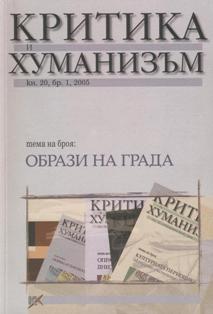Какво символизира "Символът на София"?
What the symbol of Sofia symbolizes
Author(s): Valentin DanchevSubject(s): Social Sciences
Published by: Фондация за хуманитарни и социални изследвания - София
Keywords: city; symbol; metropolitan symbol; Sofia; everyday life; heterogeneous environment
Summary/Abstract: The paper attempts to answer how come that in the summer of 1998 the municipal authorities of Sofia all of a sudden decided to erect a “united metropolitan symbol”. What were the actual prerequisites and shortcomings that mobilized this unexpected administrative exercise in symbolic construction, given the long-term existence of Sofia (as a city and as a capital city) without any unified symbolic image? The question gets even deeper by virtue of two “seemingly” paradoxical circumstances. First, the monumental work - a statue-symbol named “St. Sofia” does not incorporate any meanings referring to some historically specific or actually lived urban relations inscribed in the city space. Second, in the public scandal accompanying the erection of St. Sofia statue a stance was articulated that its design represented the result of a misinterpretation of the name of the capital city. The religious orthodox canons emphasized the historical fact that the name of the city came after the ancient temple “St. Sofia”, which was devoted to Christ as Wisdom of God (in Greek sophia) and had nothing to do with the sculptured image of a “young woman, pretty and wise, cultured and honorable, tempting and mysterious”, in short, the martyr Sofia with her daughters Faith, Hope, Love. Such a contradictory situation evokes the impression of “senselessness”, “lack of logic”, and “thoughtlessness” of the statue-symbol, and hence there is only one step to the easy statement that its “ideologists” were wrong to place it in the center of the city space. This paper departs from the deceptively smooth resolutions, and tries (through a reconstruction of the discourses of argumentation in the public debate and of their social and institutional embeddedness) to decipher the dynamic ensemble of structural social interrelations, which construct the “Symbol of Sofia” as it is determined. After tracing back the web of actions for the creation of the “Symbol of Sofia”, the research finds out that the sculpture is in fact completely “logical”, since it represents an ensemble of socially valid principles, values, and practices, which in their type are adequate to the asymmetrically made up approach of organizing the urban environment. Along those lines it becomes now quite understandable why the “symbol of Sofia” sculpture does not represent any social relations that might be more or less relevant to the variety of public subjects in the capital city space. It, instead, rather replaces the relations and their public relevance by “imagining” a coherent value framework - the religious (Christian) roots of Sofia. That “substitution” already elucidates why the personal decision for erecting a united symbol of Sofia was not submitted to a preliminary debate, which could publicly put in question and deliberate, first, the conditions of (im)possibility of an united symbol within a heterogeneous metropolitan environment, and, second, the meanings that might be sig
Journal: Критика и хуманизъм
- Issue Year: 2005
- Issue No: 20
- Page Range: 157-176
- Page Count: 20
- Language: Bulgarian
- Content File-PDF

